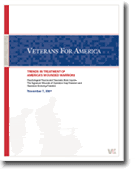VFA Releases Report on the Treatment of America's Wounded Warriors
 Released earlier this month, the Veterans For America 24-page Trends in the Treatment of America's Wounded Warriors report examines both psychological trauma and traumatic brain injuries. From VFA:
Released earlier this month, the Veterans For America 24-page Trends in the Treatment of America's Wounded Warriors report examines both psychological trauma and traumatic brain injuries. From VFA:
VFA investigators have visited every demobilization site in the United States and overseas, where they have monitored the quality of treatment, family support, rehabilitation, and other services that should enable a wounded servicemember to readjust to civilian life.
VFA has found that medical care for mental health and TBI is often inadequate or poorly delivered, and when a servicemember is discharged, decisions are often made by the military that negatively affect veterans for the rest of their lives.
VFA has also found that little consideration is given to TBI or PTSD in the military justice system despite the fact that these wounds are known to cause improper behavior. Lack of capabilities to treat these injuries, inadequate adherence to the Congressional inquiry process, and the inability or unwillingness to treat PTSD and TBI as wounds of equal legitimacy as physical injuries are some problems that require improved military leadership.
This report incorporates VFA investigative findings with open-source DoD and other reports and articles to provide a comprehensive picture of the state of care for America’s wounded warriors.
In educational interest, article(s) quoted from extensively.
Continuing:
Almost 1.6 million American service members have deployed to OIF and OEF, and over 525,000 have deployed more than once. The demographics of these men and women are fundamentally different from those who served in America’s previous conflicts. The average age of an active component service member deployed since September 11, 2001, is 27, and the average age of someone serving in the National Guard or Reserves in Iraq or Afghanistan is 33. In contrast, the average age of an American service member serving in combat in Vietnam was 19.
Most service members in previous wars were single men who deployed only once. Today 60 percent of those deployed have family obligations; ten percent of those deployed are women; 16,000 women who have deployed are single mothers. As of October 29, 2007, at least 3,839 U.S. service members have died in Iraq and 453 U.S. service members have died in Afghanistan. Tens of thousands of service members have suffered physical wounds. Hundreds of thousands more have sustained mental injuries and/or mild traumatic brain injuries, many of which have not been properly diagnosed.
Of those who have given their lives in OIF or OEF, 47 percent have left spouses and/or children behind. Two hundred and twenty-nine thousand veterans of OIF and OEF sought treatment from the Department of Veterans Affairs between 2002 and December 2006. According to military mental health experts, if current trends continue, over 75 percent of Soldiers and Marines in Iraq will be in a situation where they could be seriously injured or killed. Nearly two-thirds of them will know someone seriously injured or killed.
Thirty percent of Soldiers and Marines in high combat situations (those who spend over 56 percent of their time off base) will develop a mental health problem, such as depression or post-traumatic stress disorder (PTSD); for members of the National Guard, the rate rises to 49 percent. A crisis in the DoD mental health treatment system compounds these problems. ...
Members of the Guard and Reserve who have served in Iraq and Afghanistan also deserve special attention. Our country never expected to use these troops as heavily as we have in Iraq and Afghanistan; consequently, after having been deployed, sometimes multiple times, these troops are experiencing rates of mental health problems 44 percent higher than their active duty counterparts. Based on available evidence, VFA believes that a considerable percentage of members of the Guard and Reserve have undiagnosed—and hence untreated—service connected TBI’s.
Since our country did not expect to use these service members to the degree that we have, we do not have sufficient programs in place to help these service members when they come home. Among other disconcerting signs, when compared to active-duty service members, members of the Guard and Reserve are half as likely to file a VA claim and are twice as likely to have their claim rejected. Urgent action is required to ensure that the service-connected mental health and TBI needs of these warriors are met.
Women comprise about 10 percent of the U.S. force in Iraq and Afghanistan. This is markedly higher than has served in previous U.S. conflicts. For instance, women comprised less than 0.01 percent of U.S. forces in Vietnam. In addition, more than 16,000 single mothers have served in our recent wars. These new realities are, again, challenging existing DoD and VA structures. For instance, the VA only has two inpatient facilities devoted solely to treating service-connected PTSD for female veterans.
Download full report [pdf].

Related Posts


